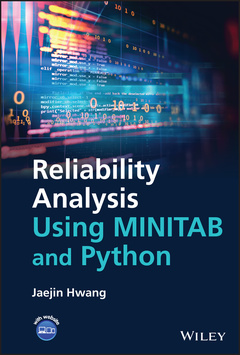Reliability Analysis Using MINITAB and Python
Auteur : Hwang Jaejin

Complete overview of the theory and fundamentals of Reliability Analysis applied with Minitab and Python tools
Reliability Analysis Using Minitab and Python expertly applies Minitab and Python programs to the field of reliability engineering, presenting basic concepts and explaining step-by-step how to implement statistical distributions and reliability analysis methods using the two programming languages. The textbook enables readers to effectively use software to efficiently process massive amounts of data while also reducing human error.
Examples and case studies as well as exercises and questions are included throughout to enable a smooth learning experience. Excel files containing the sample data and Minitab and Python example files are also provided.
Students who have basic knowledge of probability and statistics will find this textbook highly approachable. Nonetheless, it also covers material on basic statistics at the beginning, so students who are not familiar with statistics can follow the material as well.
Written by a highly qualified author in the field, sample topics covered in Reliability Analysis Using Minitab and Python include:
- Establishing a basic statistical background, with a focus on probability, joint probability, union probability, conditional probability, mutually exclusive events, and bayes? rule
- Statistical distributions, with a focus on discrete cases, continuous cases, exponential distribution, Weibull distribution, normal distribution, and lognormal distribution
- Reliability data plotting, with a focus on straight line properties, least squares fit, linear rectification, exact failure times, and readout failure data
- Accelerated life testing, with a focus on accelerated testing theory, exponential distribution acceleration, and Weibull distribution acceleration
- System failure modeling, with a focus on reliability block diagram, series system model, parallel system model, k-out-of-n system model, and minimal paths and minimal cuts.
- Repairable systems, with a focus on corrective and preventive maintenances, availability, maintainability, and preventive maintenance scheduling
Reliability Analysis Using Minitab and Python serves as an excellent introductory level textbook on the topic for both undergraduate and graduate students. It presents information clearly and concisely and includes many helpful additional learning resources to aid in understanding of concepts, information retention, and practical application.
About the Author ix
Preface xi
Acknowledgments xiii
About the Companion Website xv
1 Introduction 1
1.1 Reliability Concepts 1
1.1.1 Reliability in Our Lives 1
1.1.2 History of Reliability 2
1.1.3 Definition of Reliability 2
1.1.4 Quality and Reliability 3
1.1.5 The Importance of Reliability 4
1.2 Failure Concepts 5
1.2.1 Definition of Failure 5
1.2.2 Causes of Failure 5
1.2.3 Types of Failure Time 7
1.2.4 The Reliability Bathtub Curve 12
1.3 Summary 16
2 Basic Concepts of Probability 19
2.1 Probability 19
2.1.1 The Importance of Probability in Reliability 20
2.2 Joint Probability with Independence 20
2.3 Union Probability 21
2.4 Conditional Probability 22
2.5 Joint Probability with Dependence 22
2.6 Mutually Exclusive Events 23
2.7 Complement Rule 24
2.8 Total Probability 24
2.9 Bayes’ Rule 25
2.10 Summary 26
3 Lifetime Distributions 29
3.1 Probability Distributions 29
3.1.1 Random Variables 29
3.2 Discrete Probability Distribution 30
3.3 Continuous Probability Distribution 32
3.3.1 Reliability Concepts 33
3.3.2 Failure Rate 35
3.4 Exponential Distribution 37
3.4.1 Exponential Lack of Memory Property 40
3.4.2 Excel Practice 41
3.4.3 Minitab Practice 41
3.4.4 Python Practice 43
3.5 Weibull Distribution 46
3.5.1 Excel Practice 52
3.5.2 Minitab Practice 52
3.5.3 Python Practice 53
3.6 Normal Distribution 54
3.6.1 Excel Practice 60
3.6.2 Minitab Practice 60
3.6.3 Python Practice 62
3.7 Lognormal Distribution 63
3.7.1 Excel Practice 66
3.7.2 Minitab Practice 66
3.7.3 Python Practice 68
3.8 Summary 70
4 Reliability Data Plotting 77
4.1 Straight Line Properties 77
4.2 Least Squares Fit 79
4.2.1 Excel Practice 81
4.2.2 Minitab Practice 82
4.2.3 Python Practice 82
4.3 Linear Rectification 84
4.4 Exponential Distribution Plotting 84
4.4.1 Excel Practice 92
4.4.2 Minitab Practice 92
4.4.3 Python Practice 94
4.5 Weibull Distribution Plotting 96
4.5.1 Minitab Practice 99
4.5.2 Python Practice 100
4.6 Normal Distribution Plotting 103
4.6.1 Minitab Practice 105
4.6.2 Python Practice 105
4.7 Lognormal Distribution Plotting 106
4.7.1 Minitab Practice 108
4.7.2 Python Practice 110
4.8 Summary 111
5 Accelerated Life Testing 115
5.1 Accelerated Testing Theory 115
5.2 Exponential Distribution Acceleration 117
5.3 Weibull Distribution Acceleration 118
5.3.1 Minitab Practice 119
5.3.2 Python Practice 120
5.4 Arrhenius Model 123
5.4.1 Minitab Practice 125
5.4.2 Python Practice 127
5.5 Summary 129
6 System Failure Modeling 131
6.1 Reliability Block Diagram 131
6.2 Series System Model 132
6.3 Parallel System Model 135
6.4 Combined Serial–Parallel System Model 138
6.5 k-out-of-n System Model 140
6.6 Minimal Paths and Minimal Cuts 142
6.7 Summary 148
7 Repairable Systems 151
7.1 Corrective Maintenance 151
7.2 Preventive Maintenance 152
7.3 Mean Time between Failures 152
7.4 Mean Time to Repair 153
7.5 Availability 153
7.5.1 Inherent Availability 153
7.5.2 Achieved Availability 154
7.5.3 Operational Availability 155
7.5.4 System Availability 156
7.6 Maintainability 156
7.7 Preventive Maintenance Scheduling 157
7.7.1 Python Practice 160
7.8 Summary 161
8 Case Studies 165
8.1 Parametric Reliability Analysis 165
8.1.1 Description of Case Study 166
8.1.2 Minitab Practice 166
8.1.3 Python Practice 177
8.2 Nonparametric Reliability Analysis 184
8.2.1 Description of Case Study 184
8.2.2 Minitab Practice 185
8.2.3 Python Practice 189
8.3 Driverless Car Failure Data Analysis 190
8.3.1 Description of Case Study 190
8.3.2 Minitab Practice 193
8.3.3 Python Practice 199
8.4 Warranty Analysis 202
8.4.1 Description of Case Study 202
8.4.2 Minitab Practice 204
8.5 Stress–Strength Interference Analysis 210
8.5.1 Description of Case Study 210
8.5.2 Minitab Practice 211
8.5.3 Python Practice 213
8.6 Summary 214
Index 219
Jaejin Hwang is Associate Professor in the Industrial and Systems Engineering Department at Northern Illinois University, USA. He received his PhD in Industrial and Systems Engineering from Ohio State University, USA, in 2016 and has published two books with CRC Press and Mercury Learning & Information respectively. He has also been a guest editor for the International Journal of Environmental Research and Public Health.
Date de parution : 11-2022
Ouvrage de 240 p.



